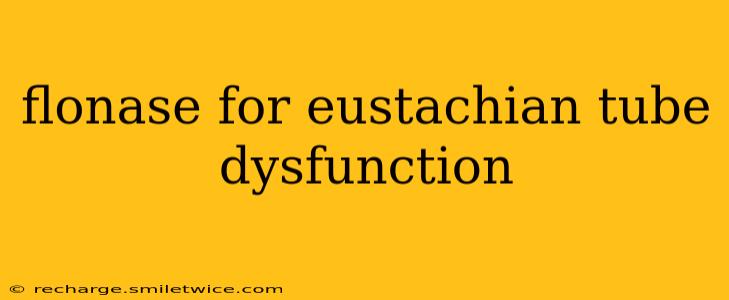Eustachian tube dysfunction (ETD) can be incredibly frustrating, causing ear pressure, muffled hearing, and even pain. Many sufferers search for effective relief, and Flonase, a nasal corticosteroid spray, often comes up in the conversation. But does it actually work for ETD? Let's explore the evidence and understand how Flonase might (or might not) help.
What is Eustachian Tube Dysfunction (ETD)?
Before we dive into Flonase, it's crucial to understand ETD. The Eustachian tubes are small canals connecting the middle ear to the back of the throat. Their job is to equalize pressure on both sides of the eardrum. When these tubes become blocked or malfunction, it leads to ETD. This can be caused by various factors, including:
- Allergies: Inflammation from allergens can swell the tissues surrounding the Eustachian tubes, hindering their function.
- Infections: Upper respiratory infections (URIs), such as the common cold or the flu, can inflame the tubes and lead to temporary dysfunction.
- Structural abnormalities: In some cases, anatomical differences in the Eustachian tube structure can contribute to chronic ETD.
- Changes in air pressure: Rapid changes in altitude (like during air travel) can disrupt pressure equalization.
Can Flonase Help with Eustachian Tube Dysfunction?
Flonase, containing fluticasone propionate, is a nasal corticosteroid commonly used to treat allergies and nasal inflammation. Because inflammation often plays a role in ETD, it's logical to consider Flonase as a potential treatment. However, the evidence is mixed.
While Flonase can reduce nasal inflammation, its direct effect on Eustachian tube function is less clear-cut. Some studies suggest that by reducing nasal congestion and inflammation, Flonase might indirectly improve Eustachian tube drainage and function. This could lead to some relief from symptoms like ear pressure and fullness. However, it's not a guaranteed solution, and Flonase is not specifically FDA-approved for treating ETD.
How Does Flonase Work for ETD (if at all)?
Flonase's potential benefit for ETD stems from its anti-inflammatory properties. By reducing swelling in the nasal passages, it might alleviate pressure on the Eustachian tubes and improve their ability to open and close properly. This could lead to improved ventilation in the middle ear and subsequent relief from symptoms.
What are the Side Effects of Using Flonase?
Like any medication, Flonase can have side effects, although they are generally mild. Common side effects include:
- Nosebleeds
- Headaches
- Sore throat
- Nasal irritation
Is Flonase a Cure for Eustachian Tube Dysfunction?
It's crucial to understand that Flonase is not a cure for ETD. It may provide symptomatic relief for some individuals, particularly those whose ETD is allergy-related. However, it won't address underlying structural issues or severe infections.
When Should You See a Doctor for Eustachian Tube Dysfunction?
If you experience persistent ETD symptoms, such as prolonged ear pressure, hearing loss, or ear pain, it's crucial to seek medical attention. Your doctor can properly diagnose the cause of your ETD and recommend appropriate treatment, which may include:
- Decongestants: To temporarily reduce swelling.
- Antibiotics: If an infection is suspected.
- Valsalva maneuver: A technique to equalize pressure in the middle ear.
- Balloon dilation: A procedure to widen the Eustachian tube.
- Surgery: In rare cases, surgery may be necessary.
What other treatments are available for Eustachian Tube Dysfunction?
Besides Flonase, other treatments for ETD include decongestants (oral or nasal sprays), saline nasal sprays, and sometimes antibiotics if an infection is present. Your doctor can determine the best course of action based on your individual circumstances and the cause of your ETD.
Can I use Flonase long-term for ETD?
Long-term use of Flonase should only be done under the guidance of a doctor. While generally safe for long-term use in managing allergies, the potential benefits and risks for chronic ETD need to be evaluated on a case-by-case basis.
Conclusion:
Flonase might offer some relief from the symptoms of ETD for some individuals, primarily by reducing nasal inflammation. However, it is not a cure and shouldn't be considered a first-line treatment. Always consult a doctor for proper diagnosis and treatment of Eustachian tube dysfunction. They can determine the underlying cause of your symptoms and recommend the most appropriate course of action. Remember, self-treating can be risky, so professional medical guidance is paramount.
